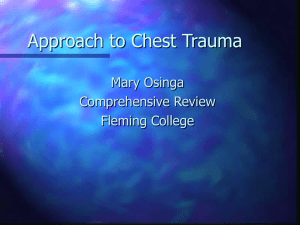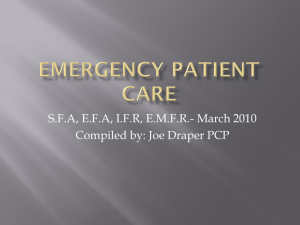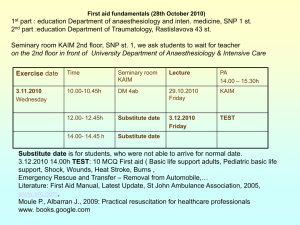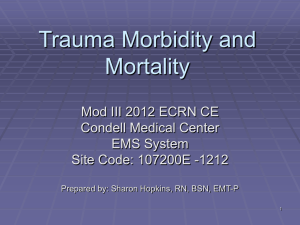Trauma Patient Assessment PowerPoint ALS-ILS-BLS
advertisement
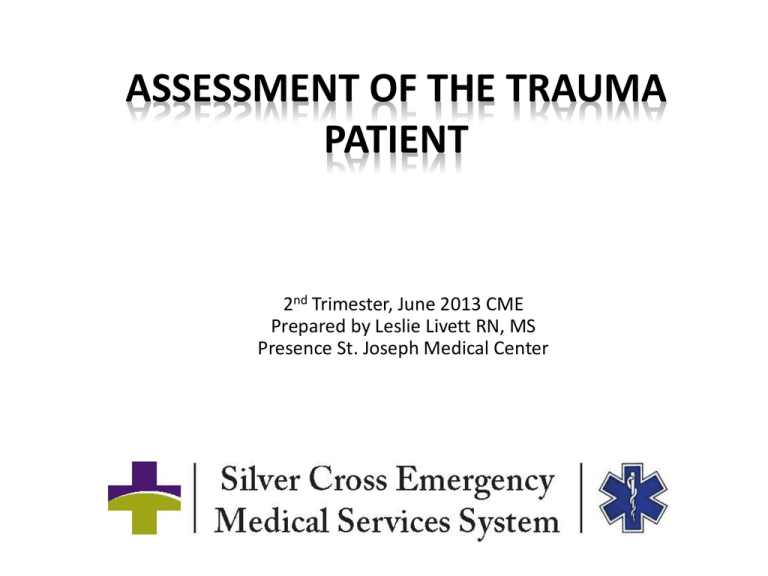
ASSESSMENT OF THE TRAUMA PATIENT 2nd Trimester, June 2013 CME Prepared by Leslie Livett RN, MS Presence St. Joseph Medical Center Objectives • Upon successful completion of this module, the EMS provider should be able to: – Understand what the mechanism of injury is and the information it provides – Describe assessment and treatment appropriate for the patient with traumatic insult • Tension pneumothorax, sucking chest wound, flail chest, eviscerated organs – Successfully identify the landmark and perform chest needle decompression – Actively participate in trauma scenario discussion Definition • Damage to the body caused by an exchange of energy beyond the body’s resilience. Epidemiology of Trauma • • • • Leading cause of death in ages 1-44 3rd leading cause of death for all ages 100,000 deaths/year 60 million injuries/year Overall Approach • • • • • • Anticipate the worst Never make any assumptions History and Exam have to make sense Don’t take short cuts Document frequently TEAMWORK Don’t get distracted with “ugly injuries” Your Initial assessment findings will determine how you will proceed • Caveats in Elderly: – Loss of Reserve Function – Assume that every organ has some degree of loss – Improve outcomes Trauma System Mortality is decreased when The RIGHT patient Gets to The RIGHT hospital In the RIGHT AMOUNT of TIME A B C’s of Trauma Care • Many ways to interpret that • The original way A Airway with C-spine B Breathing C Circulation The New Way A Airway B Be Careful of the Airway C Concentrate on the Airway (An Amusing Variation) • A Antibiotics • B Blood Cultures • C Consults • A Always • B Bring • C Camera Approach to Trauma • • • • Challenging Systematic Approach to Patient Care Logical & Organized Mechanism of Injury General Assessment Pearls • With restlessness and agitation, you must consider – hypoxia, – shock, – influence of alcohol and/or drugs – need to assess for all reasons of restlessness. – don’t not just stop when you discovered one cause – there may be more than one pathology going on at a time AIRWAY • Way back in 1983, studies showed us that NO Airway or a DELAYED airway was the single most important cause of mortality in trauma If you THINK you need an airway …. YOU DO Airway Assessment Maneuvers in Trauma • Inspection – Color, contour, symmetry, smell, audible abnormal sounds, obvious wounds • Palpation – Textures, moisture, pulsations, deformities, crepitus, masses, temperature • Percussion – Resonant = normal – Hyperresonant = more air – Dull = solid, fluid • Auscultation Focused History Physical Exam • As you approach: OBSERVE – Level of Consciousness – Appearance – Restlessness – Distress/Pain – Hemorrhage/Gross Deformities – Unusual odors – Kinematics Airway & C-Spine • • • • Access Assess Maintain Cervical Spine Control Airway Compromised • What are some etiologies of a compromised/ obstructed airway in trauma? Airway Compromised • Discuss: What are some causes of a compromised/ obstructed airway in trauma? Airway Assessment • • • • Observe for Respiratory effort Symmetry Accessory muscles Audible sounds – What should ventilations sound like? • Ability to talk • Impaired laryngeal reflexes Airway Intervention • Position Appropriately • Reposition Mandible – Chin lift, jaw thrust – DO NOT • Hyperextend or Hyperflex • Remove Debris/Suction • Maintain with Adjuncts Airway Adjuncts • Nasopharyngeal if awake • Oropharyngeal if unconscious/no gag • Rescue: – BVM, Intubation,King LTS-D, Airway Adjuncts • Lower Airway – Needle Cricothyrotomy – Quick-trach Need to secure your airway & always reassess! Spine Precautions • Manual in-line stabilization – Maintain axial alignment • Apply c-collar • Provide lateral immobilization Airway Caveats in special populations • Obese – Sleep apnea, elevate head of bed, difficult access to airway • Elderly – Spine/arthritic changes – Dental appliances Breathing • Inspect – Expose the chest • Palpate • Percussion • Auscultate Breathing Inspect RATE, PATTERN, DEPTH, EFFORT • Appearance • Symmetry • Signs of past trauma • Accessory muscles • Speech • Jugular veins • Cough Breathing Palpate • • • • • • • • • Pain, point tenderness Deformity Chest wall expansion Mobility Crepitus Skin temp/moisture SQ emphysema Tactile fremitus Position of the trachea Breathing Percussion • Hyperresonance – Pneumothorax or emphysema • Dull – Blood from hemothorax Breathing Auscultate • Perform immediately if in distress – Audible – Listen • Ominous sound = silence • Tissue mismatch: reflects sound away Breathing Auscultate • Where to listen? – Epigastrium (first after intubation) – Anterior – Lateral – Posterior Breathing Compromise • • • • • • • • • • • Dyspnea Bradypnea: weak/shallow Tachypnea Cough Diminished or absent breath sounds Signs of chest trauma Increased effort using accessory muscles SQ emphysema Unequal pulmonary excursion Hypoxia/cyanosis Restlessness Breathing Intervention • Pulse OX (SpO2) • Oxygen (NRB) Breathing Life Threats • • • • Tension Pneumothorax Open Pneumothorax Flail Chest Massive Hemothorax Needle Decompression • Landmarks anterior approach – 2nd intercostal space in the midline of the clavicles – Place prepared flutter valve needle over the top of the rib • Avoids potential injury to vessels and nerves that run along the bottom of the rib Quick Way to Find 2nd ICS • Feel for the top of the sternum • Roll your finger tip to the anterior surface at the top of the sternum • Feel the little bump near the top of the sternum – This bump is the Angle of Louis • From the Angle of Louis slide your fingers angled slightly downward toward the affected side following the rib space – You are automatically in the 2nd ICS • Identify the midline of the clavicle – The midline is more lateral than persons realize and usually runs in line with the nipple Alternate Method to Find 2nd Intercostal Space • Palpate the clavicle and find the midline – The midline is farther out (more lateral) from the sternum than most persons realize • Move your finger tips under the clavicle into the 1st intercostal space – 1st rib is under the clavicle and is not palpated – Spaces identified for the numbered rib above the space • Feel for the firm 2nd rib and palpate the soft space below the rib – This is the 2nd ICS Needle Decompression • Find your own 2nd ICS • Now find your neighbor’s 2nd ICS – Use both methods to find the landmark and decide which is easiest for you • Documentation – To include signs and symptoms – Size of needle used (length and gauge) – Site needle inserted into – Response from the patient Equipment • Long needle (preferably 2-3 inch) and large bore needle (preferably 12-14G) • Flutter valve – Not required by system, but can be helpful – Commercial devices, or finger from a glove • Cleanser to prepare skin • Method to secure needle in place – Skin will most likely be diaphoretic – Tape may not stick – May need to maintain manual control of needle Skin Preparation Midline of clavicle 2nd ICS Angle of Louis Inserting the Needle • Remove proximal end cap from needle – Will be able to hear trapped air escaping • Needle inserted over top of rib – Once hiss of air heard continue to advance catheter while withdrawing stylet • Stabilize catheter as best as possible • Patient should symptomatically improve – Do not expect to hear improved breath sounds; takes time for the lung to reexpand Case Study #1 • EMS is called to the scene for a 52 year-old male with c/o sudden onset dyspnea with pain between his shoulder blades while watching TV at home. The patient is agitated, short of breath, with increased respiratory rate and SaO2 of 89%. • Further assessment reveals decreased breath sounds on the right and clear on the left • Vital signs: 98/62; HR 118; RR 32 and shallow • Your impression & intervention plan? Case Study #1 • Spontaneous tension pneumothorax – They don’t all develop from trauma • Begin supplemental oxygen support via nonrebreather, cardiac monitor, preparation for IV BUT • Quickly prepare for needle decompression while the above are being prepared – Patients with a tension pneumothorax can’t wait and will deteriorate without needle decompression Sucking Chest Wound • Most common with penetrating wounds • Free passage of air between the atmosphere and pleural space if the open wound is at least 2/ rd the size of the diameter of the trachea 3 – Size of trachea about the size of pt’s 5th finger • Air is drawn into the chest cavity • Air replaces lung tissue • Lung collapses Sucking Chest Wound • Severe dyspnea • Open chest wound – Check anterior, posterior, axilla areas • Frothy blood at wound opening • Sucking sound as air moves in and out • Tachycardia with hypovolemia Treatment Sucking Chest Wound • Immediate treatment is to seal the opening – May start by placing a gloved hand over the wound – When able, place an occlusive dressing, taped on 3 sides, over the wound • Wound now converted to a closed pneumothorax • Monitor for signs of tension pneumothorax – May need to lift a corner of the dressing to release trapped air via burping dressing Flail Chest • 3 or more adjacent ribs broken in 2 or more places – Segment becomes free with pardoxical chest wall motion during respirations – Paradoxical movement more evident after the muscles splinting the flail segment fatigue • Usually takes a tremendous amount of blunt trauma to cause a flail chest • Often present will be associated severe underlying injury (ie: pulmonary contusion) • Respiratory volume reduced and respiratory effort increased Treatment Flail Chest • Place patient on the injured side (may not be possible to do this in the field based on mechanism of injury) • High flow oxygen – nonrebreather mask – Monitor for need to assist ventilations via BVM to deliver positive pressure ventilations • Evidence of underlying pulmonary injury • Effort and fatigue • Pulse oximetry • EKG monitoring – Tremendous amount of force is delivered to the chest wall and cardiac injury is highly likely as a result Breathing Caveats • Elderly: – Pulmonary system is the leading cause of posttraumatic complications – Consider the need to intubate – Caution to over-correct patients with COPD – But Never withhold oxygen to any patient who needs it Breathing Caveats • Morbidly Obese: – Difficult assessment – SpO2 monitoring – CO2 retention may occur often – Tension Pneumo might need 10g (longer than 14g) Circulation Assessment • Pulses – Radial: B/P 80-90 mm Hg – Femoral: B/P 70mm Hg – Carotid: B/P 60mm Hg – Rapid, thready, >120 = probable shock Circulation Assessment • Perfusion – Mental status – Skin color/temp of extremities – BP/secondary survey – Quality of the peripheral pulse Circulation Assessment • Skin Color, Temperature, & Moisture – Vasoconstriction = shock • Cap Refill < 2 sec • Level of Consciousness – Indicator of central perfusion • Bleeding – Location, type, amount, & rate Circulation Life Threats • • • • PEA Cardiac Tamponade Shock Massive Hemothorax > 1,500 ml Circulation Resuscitation • • • • • • CPR, if needed Control bleeding IV access Fluids EKG monitoring MAST Pants/PASG no longer required on ambulance by IDPH FLUIDS • Adults – “Fill the Tank” – Not always effective… filling tank with water will not allow engine to run – But sometimes it’s all we have – Bolus isotonic fluid to maintain effective systolic BP • Pediatrics – 20 cc/Kg then maintenance Circulation Caveats • Elderly & Morbidly Obese – Fluid loading is poorly tolerated – Vascular access may be difficult – ECG changes • Pregnant patients – Blood supply increases significantly in a woman who is at full term – More information on that coming up toward the end of this presentation Disability • Level of consciousness – Best indicator of central perfusion & deterioration of patient status • Pupils • Glucose Level Disability Assessment • Glasgow “best” response – Eye opening – Verbal response – Motor response • Total 3-15 • There is no such thing as a GCS of “zero”. Even a rock has a GCS of at least 3. GCS Pearls • Acceptable noxious stimuli – Armpit pinch or nailbed pressure – Sternal rub, pinching web space between fingers, pinching shoulder muscle (trapezius) – Earlobe pinch is out of favor • Can cause movement of head & neck in response to the pain GCS Pearls • The change in the GCS is more important than the absolute score • Check for associated injuries – Manage a head injury as a multiple injured patient until other injuries ruled out • Stabilize the neck for any head injury • Don’t assume the level of consciousness is altered just because of ETOH and/or drugs – Is there an occult (hidden) injury present? • Provide accurate, clear, detailed documentation Disability Assessment • Possible causes of altered mental status: AEIOUTIPS – – – – – – – – – Airway Endocrine Insulin Overdose Uremia Trauma/tumors Infection Psychosis Shock/seizures Disability Caveats • Elderly: – Hearing, visual, cognition, memory, perception, communication, and motor deficits – ≥ 65 with GCS ≤ 8 is poor prognosis – ≥ 65 with RTS < 7 has 100% mortality – Don’t control all restlessness with sedation Disability Caveats • Morbidly obese: – Supine position = decrease range of motion – Strength may be difficult to determine – Look for asymmetry for injury Environment/Exposure • Flip them (back) • Strip them (wounds, burns) • Keep warm • Caveats: – Elderly: increase in hypothermia – Morbidly obese: pull back skin • Vital signs – BP, HR, RR, Temp • Manual BP • Pulse pressure – Narrowed = bleeding (<30 mmHg) – Widened = increase ICP (>50 mmHg) • Pulse – Conscious palpate radial – Unconscious palpate carotid – Normal 60-100 – Bradycardia vs Tachycardia – Rhythm – Quality – Location • Current & Past Health History • Sample: – S: Symptoms – A: Allergies – M: Medications – P: Past medical history – L: Last oral intake, last LMP, last TD – E: Events surrounding the incident • MOI – MVC – Falls – Struck by blunt object – Penetrating wounds – Violence/abuse Caveats in Elderly • Pain is often undertreated • Polypharmacy – they take a lot of meds already that affect their response to trauma • Increased sensitivity to side effects • Head to Toe Review – Inspect – Palpate – Anticipate – Percussion – Auscultate • Head to Toe Review – HEENT • Elderly: – brain atrophies allows more blood to accumulate without showing signs of ICP – Neck • Cervical fractures – Chest/thorax/pulmonary system • Head to Toe Review – Abdomen (inspect, listen, palpate, percuss) • • • • • • • Kehr’s sign Seat belt sign Cullen’s sign Gray-Turner’s Sign Contour Old scars Visible pulsations • Head to Toe Review • GU/Pelvis – Palpate • Gentle Inward/outward pressure • No pelvic rock • Head to Toe Review – Extremities (6 P’s of pain) – Back/Spine • Log roll – Skin & soft tissue – Neurological • LOC/GCS/Motor exam/Sensory exam Standard Monitoring • Cardiovascular – – – – – – – Peripheral pulses Skin color/temperature/moisture BP ECG Heart sounds Fluid volume (type and amount) Drainage from wounds Standard Monitoring • Neurological – Mental status (GCS) – Content arousal – Pupils – Motor/sensory exam changes – Seizure activity Evaluation Pearls – Low SaO2 • SaO2 reading may be inaccurate in the presence of: – Hemorrhagic shock with delayed capillary refill – Hypothermia – Lung damage • Evaluate all parameters together to get the best overall picture in ventilated patient – Are you able to ventilate the patient? – Are there extenuating circumstances where the circulation is affected and would affect the pulse ox reading like those listed above? More Case Studies Case Study #2 • Your 34 year-old patient received a GSW to the right upper abdomen. • They are conscious and alert; B/P 90/62; HR 120; RR 28; bleeding is minimal • What are your interventions? Case Study #2 • Make sure the scene is secured • Consider need for spinal immobilization • During assessment of wound, consider thoracic injury in addition to abdominal injury depending on the angle of the GSW. • Examine for an exit wound – Check the back and the axilla • Prepare for the worst – assume the patient will deteriorate before ED arrival • Repeat VS: B/P 80/; HR 140; RR 32, remains conscious and in pain • Transport to a Trauma Center Case Study #2 - Treatment • Routine trauma care • Question – is this an isolated abdominal wound or is it a combination abdominal/ chest wound? – Need to treat patient for potential injuries of both body cavities – EMS cannot determine in the field the angle of the trajectory • Cover the wound and watch for evisceration • Fluid resuscitation – keep B/P normal; the higher the B/P the faster the patient bleeds out Case Study #2 - Documentation • If patient states anything, put it in quotes • If information available, add angle patient shot from (ie: above, below) and distance from weapon • If known, list type of weapon used • Include results of inspection, auscultation, palpation – Location of entrance and exit wound – Size of wound(s) – Assessment of the general area (ie: contusions, bleeding, swelling/distention, pain, powder marks) • Preserve evidence as much as possible Case Study #3 • Your 10 year-old patient has a penetrating injury to the right leg above the knee while playing in his backyard • Initial VS: B/P 90/70; HR; 130; RR 32; no active bleeding • Field interventions? Case Study #3 • Next VS: B/P 92/64; HR 110; RR 20. • Stabilize foreign body in place • Obtain distal neurovascular status – Distal pulses – Movement – “can you wiggle your toes?” – Sensation – “close your eyes and tell me which toe I am touching” • Document distal neurovascular status and describe how the foreign object is stabilized in place Case Study #4 • Your 62 year-old patient had abdominal surgery 1 week ago. Today at home he sneezed hard and felt a tearing sensation in his abdomen and called EMS. • VS: B/P 100/60; HR 110; RR 24 • No active bleeding • What interventions are appropriate? Case Study #4 - Interventions • Immediately cover the wound – Need to minimize contamination – Need to prevent more organs from protruding – Need to prevent loss of fluids • Place a saline moistened dressing over the exposed tissue • Place dry gauze over the saline dressings • Can place light manual control over the organs to prevent further evisceration especially during movement, coughing, sneezing, deep breaths Case Study #5 • 21 year-old drove into a metal fence. Upon EMS arrival, there is obvious external chest injury with bleeding. Coming closer to the patient, EMS can hear a sucking sound from the chest wound. • Patient is alert, in pain, severe dyspnea • VS: B/P 90/62; HR 130; RR 34; GCS 15 • Breath sounds L > R • Look at the injury – what is your impression and what interventions are necessary? MVC Into Metal Fencing Case Study #5 • An adequate dressing will be difficult to achieve with such an extensive wound – A gloved hand just won’t be enough to get started • This patient may be a candidate for conscious sedation and intubation to provide positive pressure ventilation • Reassessment VS: B/P 80/56; HR 140; RR 36 GCS remains 15 • Transport Case Study #5 - Treatment • Open chest wounds need to be covered ASAP with a non-occlusive dressing • Carefully monitor if the treatment of the open chest wound converts the injury into a tension pneumothorax • Carefully monitor the patient for the need for more aggressive airway control (ie: supportive ventilation via BVM or intubation) – Initially can start O2 therapy with a non-rebreather mask Case Study #5 - Documentation • What – cause of the injury (penetration, MVC, pedestrian, etc) • When – the injury occurred • Where – by body location – “quadrant” refers to the abdomen – Chest injuries uses reference such as anterior/ posterior, nipple line, upper/lower chest wall • How – the injury occurred • Expand and give detail description of the injury, treatment rendered, pt response Case Study #6 • Your 45 year-old patient is a construction worker who was accidentally shot in the head with a nail gun • Upon arrival, the patient is awake, alert, talking (GCS 15) • VS: B/P 132/78; HR 96; RR 20; complains of a minor headache; minimal bleeding at a few puncture wounds noted on the occipital area of the scalp (patient has thick hair). X-ray from ED No deficits noted Case Study #6 - Treatment • Consider any injury above the level of the clavicles to include a c-spine injury until proven otherwise and immobilize the patient • Control bleeding – The face and scalp have such a rich blood supply small wounds tend to bleed heavily • Protect from further contamination – The open wound may be in direct contact with the brain • Document neurological evaluation to establish baseline for comparison (AVPU, GCS, movement) Case Study #7 • You are called to the scene for a 10 year-old female who has been run over by a bus • As patient exited bus, she bent down to tie her shoe and was caught under the wheels of the bus • Upon your arrival, you note a large amount of avulsed tissue with bleeding from the left hip, left buttock, and left upper thigh area • The patient is screaming in pain • VS: B/P 110/70; HR 110; RR 26 GCS 15 • What is your impression? 10 y/o run over by bus Case Study #7 – • General impression • Potential problems to consider & address – Massive hemorrhage & control of hemorrhage – Spinal injury – Additional injuries – Airway control – Equipment to fit a 10 year-old – Further wound contamination Lastly DOCUMENT DOCUMENT DOCUMENT Caveats in Pregnancy • • • • • General – treat the mom to treat the fetus Airway Breathing Circulation Disability Anatomical and Physiological Changes in the Pregnant Patient • Cardiovascular – Hemodynamic• Increased HR 10-20 bpm, increased SV, increased blood volume by 45-50%, increased cardiac output by 30-50%, SVR decreases – Hematologic • Increased WBC, decreased hemoglobin and hematocrit – Hypercoagulation- excessive blood clotting – Shock Considerations • May not see S & S until >30% circulating blood volume is lost!!! Anatomical and Physiological Changes (con’t) • Respiratory – Increased MR, O2 consumption, decreased CO2 • Renal – Bladder higher, kidneys dilated, increased vascularity, increased GFR • Gastrointestinal – Intestines higher, liver & spleen enlarged, prolonged gastric emptying • Reproductive – Blood flow through uterus 500-750ml/min, 1/6 total maternal BV, 10-20% of CO, hypoperfusion of uterus may occur before signs of shock • Musculoskeletal – Changes in center of gravity • Endocrine – Enlarged thyroid Strip O’ the Month • PEA – Pulseless electrical activity – Pulseless electrical activity is a clinical situation, not a specific dysrhythmia – Formerly called electromechanical dissociation (EMD) • One of the more common “death rhythms” in traumatic arrest. – So common, “trauma” used to be included in the possible causes (H’s and T’s)… but the most recent ACLS algorhythm gets a little more specific than that (hypovolemia, tension pneumo, etc). Pulseless Electrical Activity • PEA exists when organized electrical activity (other than VT) is present on the cardiac monitor, but the patient is pulseless Causes: H’s and T’s • The H’s include: – Hypovolemia, Hypoxia, Hydrogen ion (acidosis), Hyper-/hypokalemia, Hypothermia. • The T’s include: – Toxins, Tamponade(cardiac),Tension pneumothorax, Thrombosis (coronary and pulmonary). PEA – Another Way to Remember the Causes • • • • • • • • • • Pulmonary embolism Acidosis Tension pneumothorax PATCH-4-MD Cardiac tamponade Hypovolemia (most common cause) Hypoxia Heat/cold (hypothermia/hyperthermia) Hypokalemia/hyperkalemia (and other electrolytes) Myocardial infarction Drug overdose/accidents (cyclic antidepressants, calcium channel blockers, beta-blockers, digoxin) PEA – Intervention • Begin CPR • Search aggressively for possible cause(s) of the situation – Often finding the right “H” or “T” can solve PEA quickly – Most common cause: hypovolemia • Pharm: Epinephrine 1:10,000 IV/IO • No More Atropine!!! Questions? Email afinkel@silvercross.org or call 815-300-7425 (or type into text box if watching live). Thank You for Your Attention And a special thank you to Dr Wendy Marshall, Courtney McKibben RN MSN and Sharon Hopkins RN MS for the use of some of their material



